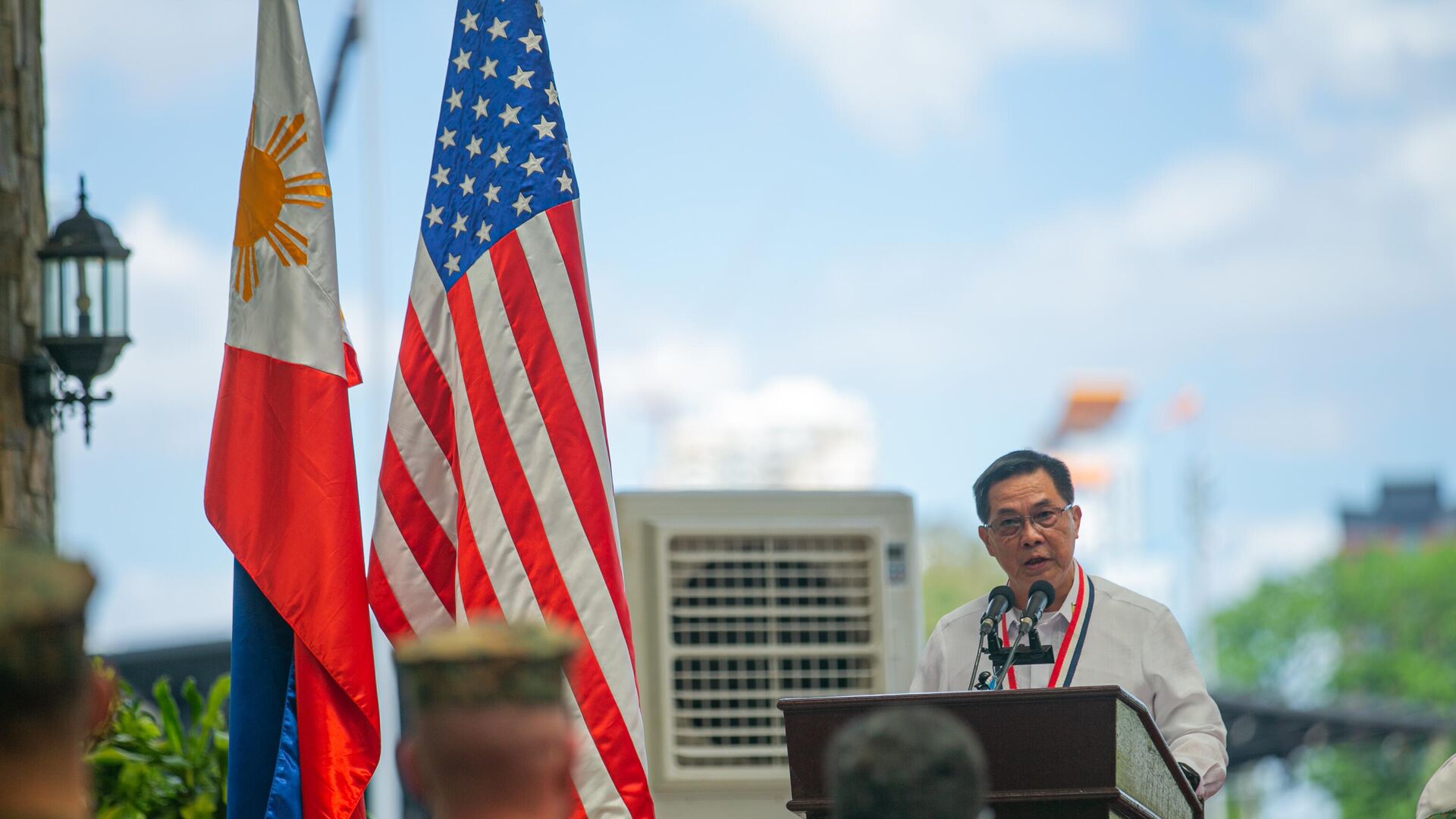https://sputnikglobe.com/20220330/us-philippines-kick-off-largest-ever-war-games-year-after-duterte-backed-off-alliance-cancelation-1094339774.html
US, Philippines Kick Off ‘Largest-Ever’ War Games Year After Duterte Backed Off Alliance Cancelation
US, Philippines Kick Off ‘Largest-Ever’ War Games Year After Duterte Backed Off Alliance Cancelation
Sputnik International
Since 2015, the size of the Balikatan drills has steadily decreased, as Manila has cozied up to China, the most likely adversary for the US and Philippines to... 30.03.2022, Sputnik International
2022-03-30T21:02+0000
2022-03-30T21:02+0000
2022-08-06T13:29+0000
philippines
joint drills
south china sea
us
https://cdn1.img.sputnikglobe.com/img/07e6/03/1e/1094339726_0:0:3073:1728_1920x0_80_0_0_d1c0f589f9ef6a4afb0c0a4518a1b43b.jpg
On Monday, the Philippines and United States kicked off 12 days of joint military drills in which roughly 9,000 troops will rehearse defending the archipelago against foreign attack - a thinly veiled reference to China.Called Balikatan, the drills are the “largest-ever iteration of the Philippine-led annual exercise,” according to a news release by US Indo-Pacific Command.However, that “friendship” was on the rocks for several years until last summer, when Philippine President Rodrigo Duterte fully restored the Visiting Forces Agreement that allows US troops to be stationed in the archipelago, after having threatened to shred it. A former colony of the United States, the Philippines has had a mutual defense treaty with the US since 1951, four years after it was granted independence.Rafael Zagala, a spokesperson for the Philippine military, told the South China Morning Post (SCMP) on Wednesday that this year’s drills marked a shift in Manila’s focus from fighting insurrections by communist militias and Muslim fundamentalists to facing down foreign foes.While not named directly, there is really only one country they have in mind: the People’s Republic of China. Manila and Beijing have sparred repeatedly in recent years over control of several small islands in the South China Sea, which sits to the west of the Philippines. Manila has carefully balanced its relations with Washington and China as each side tries to woo the country of 109 million into close cooperation. Earlier this month, the US and the Philippines signed a deal on strategic civil nuclear cooperation, in which the US will help develop Philippine nuclear power infrastructure.When it comes to the South China Sea dispute, the US has tried to promote a military showdown as the only solution, but China and the Association of Southeast Asian Nations (ASEAN), which includes the Philippines, have worked toward completing a Code of Conduct for the waterway that would govern interactions at sea.
south china sea
Sputnik International
feedback@sputniknews.com
+74956456601
MIA „Rossiya Segodnya“
2022
Sputnik International
feedback@sputniknews.com
+74956456601
MIA „Rossiya Segodnya“
News
en_EN
Sputnik International
feedback@sputniknews.com
+74956456601
MIA „Rossiya Segodnya“
Sputnik International
feedback@sputniknews.com
+74956456601
MIA „Rossiya Segodnya“
philippines, joint drills, south china sea, us
philippines, joint drills, south china sea, us
US, Philippines Kick Off ‘Largest-Ever’ War Games Year After Duterte Backed Off Alliance Cancelation
21:02 GMT 30.03.2022 (Updated: 13:29 GMT 06.08.2022) Since 2015, the size of the Balikatan drills has steadily decreased, as Manila has cozied up to China, the most likely adversary for the US and Philippines to rehearse military action against. In 2021, just 640 troops participated, in part due to COVID-19 restrictions.
On Monday, the Philippines and United States kicked off 12 days of joint military drills in which roughly 9,000 troops will rehearse defending the archipelago against foreign attack - a thinly veiled reference to China.
Called Balikatan, the drills are the “largest-ever iteration of the Philippine-led annual exercise,”
according to a news release by US Indo-Pacific Command.
“During Balikatan, the US military and AFP [Armed Forces of the Philippines] will train together to expand and advance shared tactics, techniques, and procedures that strengthen our response capabilities and readiness for real-world challenges,” Maj. Gen. Jay Bargeron, 3rd Marine Division Commanding General, said in the release. “The friendship and trust between our forces will enable us to accomplish any mission across the spectrum of military operations.”
However, that “friendship” was on the rocks for several years until last summer, when Philippine President
Rodrigo Duterte fully restored the Visiting Forces Agreement that allows US troops to be stationed in the archipelago, after having threatened to shred it. A former colony of the United States, the Philippines has had a mutual defense treaty with the US since 1951, four years after it was granted independence.
The drills will last until April 8 and involve exercises in maritime security, amphibious operations, live-fire training, urban operations, aviation operations, counterterrorism, and humanitarian assistance and disaster relief, the Pentagon said.
Rafael Zagala, a spokesperson for the Philippine military, told the
South China Morning Post (SCMP) on Wednesday that this year’s drills marked a shift in Manila’s focus from fighting insurrections by communist militias and Muslim fundamentalists to facing down foreign foes.
“Since insurgency is coming to a close, the whole armed forces will transition to external defense,” he said.
While not named directly, there is really only one country they have in mind: the People’s Republic of China. Manila and Beijing
have sparred repeatedly in recent years over control of several small islands in the South China Sea, which sits to the west of the Philippines. Manila has carefully balanced its relations with Washington and China as each side tries to woo the country of 109 million into close cooperation. Earlier this month, the US and the Philippines
signed a deal on strategic civil nuclear cooperation, in which the US will help develop Philippine nuclear power infrastructure.
When it comes to the South China Sea dispute, the US has tried to promote a military showdown as the only solution, but China and the Association of Southeast Asian Nations (ASEAN), which includes the Philippines, have
worked toward completing a Code of Conduct for the waterway that would govern interactions at sea.



